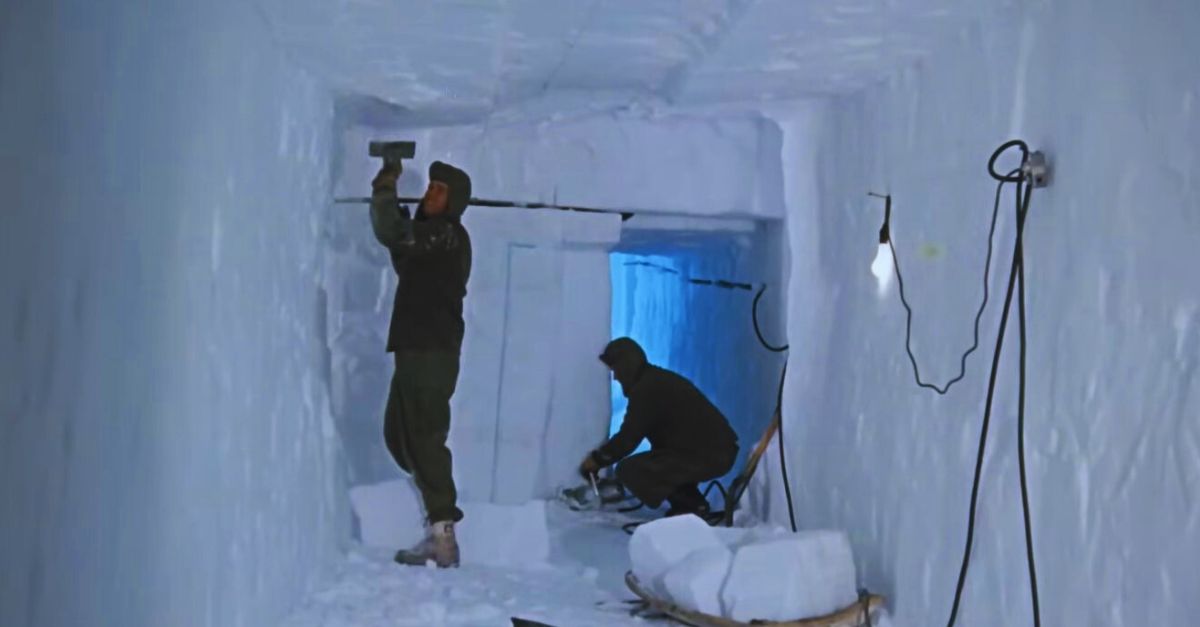Where Frost Met Fallout And Bunk Beds
Nobody expected a military outpost under miles of ice to feel like a weird college dorm, but hey—history's full of curveballs. Let’s dig into what they built and left.

NASA Uncovers The Hidden Remnants Of Camp Century
In April 2024, NASA’s UAVSAR (Uninhabited Aerial Vehicle Synthetic Aperture Radar) flew over Greenland, using synthetic-aperture radar to survey the ice cap. The radar uncovered a hidden feature beneath the ice, later identified as the remnants of Camp Century. This discovery shed new light on the buried Cold War station.
 Camp Century | The First Human Settlement under The Ice by Get.factual
Camp Century | The First Human Settlement under The Ice by Get.factual
Camp Century Had Remained Buried Deep Before This
Camp Century, once a secret US military base, lies buried beneath 100 feet (30 meters) of ice in Greenland. Abandoned for nearly 60 years, it remained hidden until NASA scientists rediscovered it. It offers a remarkable glimpse into a forgotten outpost trapped beneath layers of ice.
A City Beneath The Ice
Camp Century was a frozen frontier town buried beneath the Greenland ice. Using a cut-and-cover trenching method, engineers built a network of steel-arched tunnels to house barracks, labs, and living quarters. The town was designed to last ten years, manned for five, and abandoned after eight.
 U.S. Army Corps of Engineers, Cold Regions Research and Engineering Laboratory, Wikimedia Commons
U.S. Army Corps of Engineers, Cold Regions Research and Engineering Laboratory, Wikimedia Commons
Who Built It?
Camp Century, the “city under the ice,” was a US Army Corps of Engineers project in 1959. Tunnels were carved into Greenland's ice sheet, creating a secret base. This network of underground chambers was designed for military operations, hidden deep beneath the frozen surface.
Cold Weather Testing
In minus-70 degrees, boots cracked, and engines failed as troops tested snow tractors, thermal gear, and fuel lines—every failure a preview of battlefield collapse. In 1960, the US told Danish officials that Camp Century’s mission was to test Arctic construction, trial a mobile nuclear reactor, and conduct icecap research. Lies!
 Camp Century | The First Human Settlement under The Ice by Get.factual
Camp Century | The First Human Settlement under The Ice by Get.factual
The Hidden Agenda
Camp Century was the face, masking a base for military reasons while being disguised as a research institution for investigating Arctic conditions and performing scientific studies. The real objective was Project Iceworm: a system of tunnels for storing and launching nuclear weapons.
 Camp Century | The First Human Settlement under The Ice by Get.factual
Camp Century | The First Human Settlement under The Ice by Get.factual
The Main Street
Walk straight through Main Street, and you'll see the skeletal remains of a frozen dream. Dug into the Greenland ice sheet in 1959, this 26-foot-wide central tunnel connected labs, dorms, and the mess hall. Think of it as an icy Times Square for military engineers.
The Nuclear Reactor Chamber
In 1960, the Army installed PM-2A, a portable nuclear reactor. Buried in ice yet blazing inside, this chamber electrified Camp Century for years. Scientists monitored its radioactive heartbeat like hawks. "Controlled chaos" defined this space. You wouldn’t want a meltdown here, but you couldn’t avoid marveling at its genius.
Living Quarters For Soldiers And Scientists
Imagine bunking in a steel cocoon surrounded by endless white. Dorm life meant close quarters, stiff routines, and camaraderie born from the cold. Stories still circulate about pranks played at 2 am and socks frozen stiff overnight. These quarters served as a sanctuary and a pressure cooker.
Mess Hall Gatherings
Feast your curiosity on Mess Hall moments. Soldiers downed powdered eggs and piping-hot beverages while swapping stories about reactor buzz or collapsing tunnels. The hall served more than food. It dished out morale with every tray and tale.
Scientific Laboratories
Drill into science where it met subzero trials. Camp Century's labs tested ice physics, structural dynamics, microbial life trapped for millennia, and more. Researchers described the place as a glacier-sized petri dish where constant vibrations from drills and eerie groans from shifting ice made the labs feel alive.
Ice Core Drilling
Dig this: By 1966, Camp Century scientists had drilled 4,560 feet (1390 m) deep into the ice, pulling up climate data dating back 120,000 years. Frozen in time, each core segment whispered secrets of prehistoric storms and ancient atmospheres.
The Infirmary
Feeling under the weather in a nuclear ice base? Head to the Infirmary, a space barely more significant than a modern RV. Staffed with rotating medics and stocked with medicine, medical tools, splints, and salt tablets, this room managed frostbite and accidents (though not always in that order).
Chapel Services
Beneath the glacier, Chapel Services offered warmth, faith, and a moment of peace. Soldiers knelt on chilled benches under exposed wires and fluorescent lights. This could have easily been "God's Coldest Outpost". Even skeptics found comfort in the hymns echoing through ice-carved corridors.
 Camp Century | The First Human Settlement under The Ice by Get.factual
Camp Century | The First Human Settlement under The Ice by Get.factual
Barbershop Visits
Buzzcuts in a bunker? You bet. The Barbershop saw more gossip than grooming. Soldiers lined up to chat, complain, listen, and grab 15 minutes of normalcy while clippers hummed. Trimming hair was less about looks and more about routine. It was like a slice of civilization in a snow-swallowed military maze.
Recreation Hall
You could not get bored in the Arctic because of the Recreation Hall, which boomed with laughter from the poker games and ping-pong tournaments under fluorescent lights. Soldiers played records and staged mock "Olympics" to shake off the chill.
The Communications Center
Buried beneath snow, the Communications Center buzzed with radio static and patched calls from home. Antennas poked above the snow like periscopes. This room became a lifeline for lonely hearts and military command. Operators cracked jokes between signals, battling boredom and blizzards.
Snow Melting Units
Thirsty? These spots turned powder into potable gold. Engineers melted snow using steam coils, feeding insulated pipes that distributed water across the camp. It took thousands of gallons daily to support all personnel. Every drop had to be earned—no rain, no rivers, just tech-savvy snow sorcery.
Tunnel Construction
Constructing tunnels under 25 feet of compacted ice is no walk in the snow. Bulldozers, heated blades, and muscle sculpted a 21-tunnel grid of 9,800 feet by 1967. Tunnel Construction was backbreaking. One slip, and you'd trigger a mini avalanche. Yet, the symmetry became a geometric miracle under a frozen wasteland.
Tunnel Maintenance
Due to considerable compression, the Camp Century trenches eventually reached their design limits. So much so that extensive snow pruning became necessary to keep the tunnels in good condition. Ongoing upkeep was required to prevent collapse.
Power Plant Operations
Harnessing atomic energy under a glacier is insane. Yet, power plant operations ran like clockwork, thanks to airtight logs and radiation badges. The PM-2A reactor, housed in steel, generated 1.5 megawatts. Engineers inspected it like surgeons. Many technicians would consider it "a glowing heart in an ice coffin".
Waste Management
Waste management involved freezing sewage into metal drums. Thousands of gallons were left buried, and this is still a ticking ecological time bomb. Today, melting ice threatens to release it. Environmentalists now call Camp Century "the Arctic's radioactive Pandora's Box." Cleanups? Let’s say it's complicated.
Climate Monitoring
Forecast this: Camp Century’s climate monitoring laid the groundwork for modern climate science. Ice cores revealed ancient warming cycles and periods when Greenland was ice-free, suggesting drastically higher sea levels. Since 2017, ongoing studies have tracked snow, ice temperatures, and subsurface conditions—data now powering today’s supercomputer-driven climate models.
 Giles Laurent, Wikimedia Commons
Giles Laurent, Wikimedia Commons
Supply Chain
The supply chain meant hauling tons of gear across the ice via tracked convoys and massive sleds. Supplies came in through Thule Air Base, then trekked a couple of miles inland. There was no GPS, just compasses, radios, and guts. Every mission fought the cold so deep it cracked steel.
 Camp Century | The First Human Settlement under The Ice by Get.factual
Camp Century | The First Human Settlement under The Ice by Get.factual
Legacy Frozen In Time
So, Camp Century was an all-male space where no women served until the integration in 1978. Though declared a success in 1965, no subsurface ice cities followed. Today, above-ground buildings dot polar regions, while Camp Century sleeps buried in snow.
 Camp Century | The First Human Settlement under The Ice by Get.factual
Camp Century | The First Human Settlement under The Ice by Get.factual























